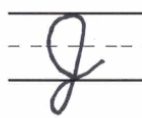I've come across two versions of writing a capital G and a capital J in cursive. I cannot understand which one is correct because Wikipedia shows that the capital G from my textbook is, in fact, the capital J from Wikipedia and vice-versa.
Is it a mistake in my textbook or one can use them interchangeably and just needs to be consistent when deciding which one to use as a capital letter?
Here are examples from my textbook.
UPDATE
Thanks. I've corrected my textbook.










